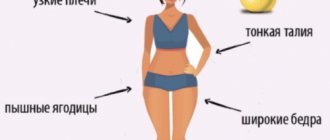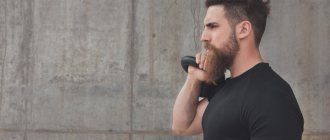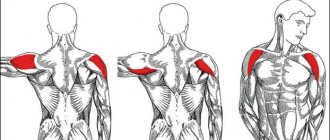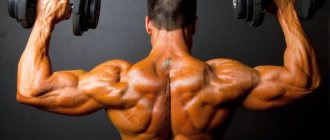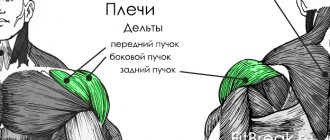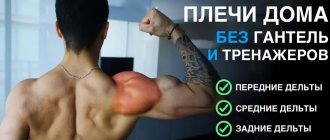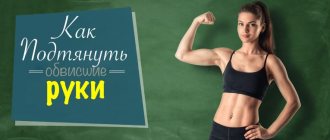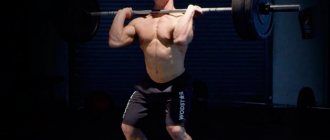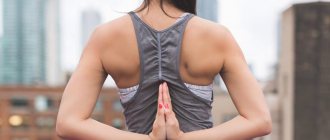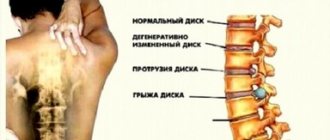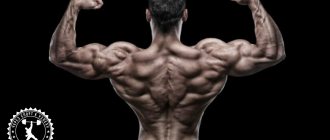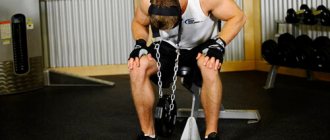For modern people, poor posture is a fairly common phenomenon. This is not surprising: the time we spend on computers or smartphones without paying attention to our posture affects the condition of our muscles and spine. One of the consequences of such negative changes is rounded shoulders.
When the back muscles are weakened, the pectoral muscles become overextended and pull the shoulders forward, resulting in what is known as slouched shoulders. Luckily, according to trainer Meg Plotsky, there are simple exercises you can do throughout the day to straighten hunched shoulders.
The mechanism of occurrence of pathology
When one shoulder is lower and the other is higher, this is always associated with curvature of the spine.
This pathology in medicine is called “scoliosis”. According to statistics, it occurs most often in children from 7 to 15 years old. After all, it is at this time that a huge load is placed on the not yet formed spine. The child is forced to sit at the table for a long time. His muscles cannot support the spine and become tired. Because of this, the child involuntarily bends his back, lowering 1 shoulder. Flexibility of the bones and laxity of the ligaments maintain the curvature, so it remains even when moving. This pathology rarely occurs in adults, and even less often they go to the clinic with it. After all, it is difficult to independently control the symmetry of the shoulder girdle, and this condition usually does not cause discomfort. The deformity is detected in an adult with back pain, numbness in the legs or arms, lameness, dizziness and other consequences. In this case, it is almost impossible to correct the situation; you can only stop the progression of the deformity.
Upper trapezius muscles
Let's start with the shoulders to relax the upper muscles. Upper trapezoids are ideal for this.
Starting position: sitting or standing on a gymnastic mat, keep your head straight.
Execution order:
- Slowly move your head to the right, your right ear should move towards your right shoulder. As you perform this movement, your left shoulder may rise slightly. If this happens, return your head to its original position and relax the muscles of your left shoulder.
- Move your right arm above your head and place your palm on your left cheekbone. Don't lower your head down, it should just rest on your hand. This will give your upper trapezius muscles a little stretch.
- Breathe calmly and sit in this pose for about 30 seconds.
- Slowly remove your hand, return to the starting position and perform similar actions with the other hand.
The right measures
How to correct spinal curvature so that treatment is as effective as possible? To do this, many factors need to be taken into account. Efficiency depends on the degree of curvature itself and the age of the patient. The sooner treatment is started, the better the results will be.
If the doctor has diagnosed the first or second degree of curvature, then conservative treatment is usually used. At this time, you need to monitor the patient's diet. It should be complete and include a large amount of vitamins and minerals. It is especially worth increasing the intake of calcium and phosphorus into the body.
In addition, you should pay attention to the bed. The firmer the mattress, the more beneficial it will be.
It is best to use special orthopedic mattresses, or use hard shields. In this case, the place to sleep must be suitable for height. A bed that is too short leads to poor posture.
Measures to correct the curvature of the spine also include the correct seat at the table. Your back should be absolutely straight and your feet should be firmly touching the floor.
Don’t forget about physical therapy as well. All exercises must be performed under the supervision of a physician in a hospital setting. Each lesson will be aimed at strengthening the core muscles, which are responsible for the correct position of the back. Water exercises and various types of corrective massages are also very effective.
Review of the best exercises
To correct the sloping shape of the shoulders, basic exercises for the deltoid muscle groups are most suitable, but along with them you can also perform several isolating strength exercises. Sloping shoulders in girls are an incorrect body position. It can be corrected with muscle strengthening or stretching. Until results from such exercises are achieved, posture can be masked with specially selected clothing.
In order to tidy up your round shoulders, you will have to exercise regularly.
How it manifests itself
Scoliosis in the initial stages is very difficult to recognize. It usually does not cause any back pain or discomfort at first. But the progression of deformation gradually leads to serious consequences
Therefore, it is very important for parents to pay attention in time to such a sign as asymmetry of the shoulders. In addition, you can notice that the child has one arm shorter than the other, the pelvis is tilted, which is why the hip joints are not in the same line. Asymmetrical placement of the shoulder blades, as well as protruding ribs, can also be symptoms of scoliosis.
Asymmetrical placement of the shoulder blades, as well as protruding ribs, can also be symptoms of scoliosis.
These signs are best seen if you ask the child to lean forward with his arms down. In this case, it will be clearly visible that the spine is curved, and one arm is longer than the other
Asymmetrical placement of the shoulder blades, as well as protruding ribs, can also be symptoms of scoliosis. These signs are best seen if you ask the child to lean forward with his arms down. In this case, it will be clearly visible that the spine is curved, and one arm is longer than the other.
Children usually have no further symptoms, other than increased fatigue. But with such a deformation, adults may experience back pain, weakness in the leg muscles, numbness or tingling of the fingers. Changes in gait and difficulty moving may develop.
Taboo
People with kyphosis also have their own forbidden exercises. These include:
- Bench press of a barbell or dumbbells, which will only tighten the thoracic region even more. The same applies to variations of bench presses in seated machines, Smith machines, and so on.
- Horizontal row in the block, which you simply cannot do correctly due to the immobility of the chest and shoulders. In any case, save this exercise for later.
- Various delt presses. The only thing worse than twisted shoulders is pumped-up, twisted shoulders. In this case, it will be much more difficult to correct the situation. Therefore, first we “open up”, and then we pump up the deltoids.
Is it possible to correct scoliosis at home?
Treatment of scoliosis depends on many factors: age, causes of the disease and the degree of its development. It includes, gymnastics,. In more severe cases, elective surgery is necessary.
What will help in the treatment of stage 1 scoliosis?
Particular attention should be paid to strengthening muscles and establishing correct posture. If your child is sick, you can send him to physical education classes
Daily morning exercises, therapeutic exercises, massage are the main therapeutic measures for first-degree scoliosis.
How to correct grade 2 scoliosis?
For the treatment of second-degree scoliosis, as with the first, physical therapy, gymnastics, and massage are prescribed. Also, wearing a special one is added to the basic procedures. It is made individually. The time of wearing the corset is gradually increased from several hours to a day.
What remedies will help cure stage 3 scoliosis?
In this case, wearing a special corset is also prescribed, but it should be worn much longer than with second-degree scoliosis. If the angle of scoliosis is greater than 45 degrees, a stabilizing system is installed on the vertebrae through surgery, which helps straighten the spine.
4th degree scoliosis
For grade 4 scoliosis, surgery is also performed. However, it is associated with a certain risk, and surgery is resorted to only when other methods fail.
Any disease is easier to prevent than to treat - this statement is true for patients with scoliosis. If a person cannot prevent congenital scoliosis, then he can prevent the development of acquired curvature. General preventive measures include: maintaining an active lifestyle, swimming, and daily exercise. It is necessary to sit at the computer as little as possible, and also take regular breaks to charge while working.
By the way, you may also be interested in the following FREE
materials:
- Free books: “TOP 7 harmful morning exercises that you should avoid” | “6 Rules for Effective and Safe Stretching”
- Restoration of knee and hip joints with arthrosis - free video recording of the webinar conducted by physical therapy and sports medicine doctor - Alexandra Bonina
- Free lessons on the treatment of lower back pain from a certified physical therapy doctor. This doctor has developed a unique system for restoring all parts of the spine and has already helped more than 2000 clients
with various back and neck problems! - Want to know how to treat a pinched sciatic nerve? Then carefully watch the video at this link.
- 10 essential nutritional components for a healthy spine - in this report you will learn what your daily diet should be so that you and your spine always have a healthy body and spirit. Very useful information!
- Do you have osteochondrosis? Then we recommend studying effective methods of treating lumbar, cervical and thoracic osteochondrosis without drugs.
Many parents notice that their child has one shoulder higher than the other. This condition sometimes also occurs in adults. It always indicates a lateral curvature of the spine. Some people think that there is nothing wrong with this, what difference does it make what level the shoulders are at. But in fact, such curvature is a serious pathology and without treatment can lead to dangerous health consequences.
Corsets for the thoracic spine
Corsets are orthopedic products that are designed to fix various parts of the spinal column.
The main functions of these products are to limit mobility or immobilize the corresponding segment of the spine, relieve muscle tension, and eliminate pain.
Wearing orthoses is indicated for the treatment of certain diseases, injuries, deformities, as well as during the recovery period after injuries or operations.
Thoracolumbar orthopedic corsets are designed for fixation of the lumbosacral and thoracic regions. They are designed to completely cover most of the chest and lower back.
Show by
The use of these orthopedic products helps:
- significantly reduce or completely eliminate pain caused by excessive tension in the back muscles;
- restore the performance of some muscles, relax others;
- correct posture, fix the spine in the correct position;
- limit the mobility of the thoracic and lumbosacral spine.
Unlike the thoracolumbar bandage, the corset has medium or high rigidity; it reliably supports the skeletal system and muscles. From another orthopedic product - reclinators, which provide rotation of the shoulders and extension of the back in the upper thoracic region - chest corsets for the spine differ in increased functionality.
Types of corsets
- Thoracolumbar orthoses are used to correct posture for scoliosis, kyphosis, intervertebral hernia, and pain caused by excessive muscle tension.
- Thoracolumbosacral corsets are used to fix the spine from the thoracic to the lumbosacral region.
Indications for wearing them may include acute or chronic pain, the need for recovery after injuries and operations, as well as some diseases: osteochondrosis, radiculitis, spondylosis, spinal curvature, etc. In orthopedic practice, a lumbosacral corset is also used, which is prescribed if fixation of the thoracic spine is not necessary. - It is recommended to buy clavicular orthoses to fix the clavicle and acromioclavicular joint in case of injuries or fractures.
According to the degree of hardness, they are distinguished:
- Rigid thoracolumbar corsets firmly fix the torso in a given position. They are used after fractures, surgery, and also for some diseases that require complete immobilization of the spine. A modern rigid thoracolumbar orthopedic corset is an excellent alternative to a bulky, uncomfortable plaster bandage. Hyperextension corsets occupy a special place among rigid fixation orthoses. Their task is not only to maintain the body in a given position, but also to change the angle of flexion and extension of the spine as necessary. Wearing such an orthosis allows the patient to move even after major surgery.
- Medium-hard and semi-rigid thoracolumbar corsets allow for good fixation, but do not immobilize a certain segment of the spinal column. They are worn during the recovery period after injuries or operations, for postural disorders, curvature of the spine, as well as for certain diseases of the thoracic or lumbar region (osteoporosis, osteochondrosis, etc.).
Choosing a corset for the thoracolumbar spine
Recommendations on choosing a suitable orthosis should be given by a specialist depending on the characteristics of the patient’s condition. When choosing the right model, the following factors are taken into account:
- presence and localization of the problem;
- required rigidity of the product;
- patient's lifestyle.
The price of a thoracolumbar corset may depend on its design, rigidity parameters, quality of materials used in its manufacture, as well as additional functionality.
It is important to understand: uncontrolled wearing of orthopedic products with a high degree of fixation can lead to adverse consequences. The muscles, constantly supported by a rigid thoracolumbosacral corset, stop working at full strength, and their recovery will take time in the future
It is worth noting that the following products enjoy the greatest demand and trust from customers:
- hyperextensor Orlett HEB-999;
- posture corrector Dosi EQ 1068.
Description of the pathology
Scoliosis (specialists also often use the term “scoliotic disease”, which refers to severe congenital deformities of the spine with a progressive course) is a vertebral pathology, a lateral or frontal curvature of the spine relative to the midline (central axis). In almost 60% of cases, scoliosis is considered idiopathic, then Yes, it is not possible to find the root cause of its development, although generally accepted risk factors for this pathology are known. Unlike sagittal curvature, which is formed in the corresponding plane (back and forth), with scoliotic deformation, certain segments of the spinal tube deviate away from its central part. The main symptom of scoliosis is the asymmetry of the shoulder girdle: one shoulder is noticeably higher than the other, while the difference between the height of the shoulders in severe forms of scoliotic disease can reach 25-30 cm.
Main signs of scoliosis
Basic analysis of postural curvatures: feet and ankles
Feet and Ankles
Just like the shoulders, hips and back, the feet and ankles also have their own proper position. When positioned correctly, the feet and ankles should point forward, not inward or outward.
Here are some common postural abnormalities in the feet and ankles. If you find yourself with one or even more of these disorders, try stretching and strengthening exercises to alleviate the problem.
Treatment
Most often, conservative therapy to correct spinal deformity is used in children. Treatment methods are selected individually depending on the degree of curvature and the age of the patient. Typically this includes physical therapy, massage, physiotherapy and wearing corsets. Only in serious cases, when the spine is tilted more than 40 degrees, is surgical correction indicated. But according to statistics, such treatment is required only in 1 case out of 1000. For the rest, constant control over posture and muscle strengthening is sufficient. In the early stages of curvature, wearing reclinators or other orthopedic devices to control the position of the shoulders is effective.
It is very important to diagnose the presence of deformity in time and begin treatment
The same methods are prescribed for deformation of the shoulder girdle in adults. Only their effectiveness will be much lower. True, it is much easier for an adult to control the position of the shoulders and correct posture. But due to the fact that at this age the curvature most often develops against the background of other pathologies, specific treatment is also necessarily prescribed, for example, drugs against osteoporosis. Treatment of spinal deformities in adults may take not a year or two, as in childhood, but much longer.
And with scoliosis in children, all responsibility for the result of treatment falls on the parents
Therefore, it is very important to know what you need to do at home in addition to the procedures prescribed by your doctor.
We also recommend reading: Types of spinal curvature
First of all, it is important what the child sleeps on. Up to 15 years, and especially if there is a curvature of the spine, it is recommended to purchase a hard or semi-rigid orthopedic mattress
It will help slow down the progression of the deformity. For school textbooks you need to buy a backpack. After all, carrying a bag on one shoulder often causes it to become lower than the other. To do homework, you need to purchase a table that matches the child’s height and a chair with orthopedic properties. It is important to constantly monitor your posture, especially while doing homework. It is at this time that the child most often lowers or raises one shoulder to compensate for the work of tired muscles. You should regularly perform special exercises prescribed by your doctor. Nutrition should be complete, balanced, and fully meet the nutrient needs of a growing body. You should not look for how to correct the deformity on your own, use traditional methods or visit chiropractors. Only a specialist, after examining and determining the cause of the pathology, can prescribe treatment.
Massage is effective for strengthening the back muscles that support the spine in the correct position
Physiotherapy
Since the most common cause of curvature is weakness of the musculo-ligamentous apparatus, the pathology is treated with special exercises. In addition to them, swimming, skiing, and outdoor games are useful. And you need to do gymnastics every day. Therapeutic exercises can be included in morning exercises or performed during the day. When exercising, you should avoid strong stretching of the back muscles and increased stress on the spine. Each exercise is performed 5-7 times. When working only on one side of the body, be sure to repeat it on the other side.
So, the execution sequence is as follows:
- Stand straight, feet shoulder-width apart, arms down. Bend to the side, with one hand sliding down the leg, the other up into the armpit.
- In the same starting position, raise one arm up. Jump your arms back. Change the position of your hands.
- Get on all fours. Raise your right arm and left leg at the same time, stretching your body.
- In the same starting position, move your arms forward with a sliding movement, arching your back, then bring your hands closer to your knees.
- Lying on your stomach, spread your arms to the sides. At the same time, raise your upper body and bend back.
- Do the same by picking up a gymnastic stick and stretching your arms forward.
- Lying on your back, raise your arms above your head. Perform bicycle and scissor exercises.
When one shoulder is higher than the other, it may simply be a poor posture that can be corrected by controlling and strengthening the muscles. But sometimes this condition is a symptom of scoliosis. Pathology should be treated as early as possible, then complications can be avoided and the health of the musculoskeletal system can be maintained.
Useful habits
The secret to straightening your shoulders and taking care of your back health lies not only in exercise, but also in developing healthy habits.
For example, take frequent breaks from sedentary work and move more—even if that means walking a couple of floors instead of using the elevator. A little office trick helps many people - placing the printer away from the desktop. So every time you need to print a document, you will be forced to walk a little.
Don't forget that your shoulders are not earrings, so don't let your neck constantly bend and your shoulders rise towards your ears.
If it is difficult to maintain your posture, it would be a good idea to purchase special pads for the chair seat, which help maintain the correct curve of the spine or special corsets. The latter can be purchased at the pharmacy.
They are invisible under regular clothes and, if chosen correctly, will help you control the position of your shoulders and avoid slouching.
Diagnostics
Before starting therapy for the defect in question, it is necessary to conduct a detailed diagnosis of this disease. After all, absolutely every organism is strictly individual, and all its characteristics must be taken into account during the therapy process. First, the doctor will talk with the patient and carefully find out what and where is bothering him. Then the shoulders and back are examined in a bent and straight position.
The chiropractor pays attention to the asymmetry of the shoulder blades, muscles and spine. The symmetry of the hips and shoulders is checked, the length of the legs is measured
X-rays of the spine are necessarily carried out in two projections: the horizontal and vertical position of the patient’s body is taken into account. Only after a detailed diagnosis do treatment begin.
Bridge
This exercise allows you to maintain good posture, develops the gluteal muscles, and strengthens the muscles of the lower back.
Starting position: lying on a gymnastic mat, legs apart hip-width apart and bent at the knees, arms extended along the body.
Execution order:
- Tighten your buttocks and lift your pelvis up, forming a straight line with your torso. Your shoulders should be on the floor.
- Maintain this position for 10 seconds, then lower your pelvis and return to the starting position.
- Perform the exercise 15-20 times. After every 5 repetitions, take a 30-second rest break.
Steps
Part 1
Posture correction
Strengthen your mid-back.
In order to correct your posture and straighten your shoulders, it is necessary to strengthen the back muscles located between the shoulder blades. These are the paraspinal (located under the spine), rhomboid, trapezius and infraspinatus (located under the shoulder blades) muscles. If these muscles are too weak, the shoulders bend forward and a slouch occurs. If the listed muscles are strong, they support the shoulders in a straightened position, promoting correct posture.
- Rowing machines are great for strengthening the muscles between your shoulder blades. Start with light weights and low reps, gradually increasing the weight and reps over 4-6 weeks of training.
- Reverse flyes with free weights are great for strengthening the rhomboids and trapezius muscles. Sit on the edge of a bench, leaning forward and looking at the floor. Take a dumbbell in each hand and lift them, spreading your arms out to the sides and squeezing your shoulder blades together. Raise your arms so that they are parallel to the floor, hold them in this position for a few seconds, then slowly lower the dumbbells.
- Swimming is another great exercise as it strengthens all muscle groups, especially the shoulders, back and legs. Swimming also helps you regain proper posture because you have to stay upright in the water, arching to keep your head above the surface of the water.
Increase the flexibility of your thoracic spine.
Although this part of the spine bends slightly forward, if it bends too much it will result in a slouched position, which can be accompanied by decreased mobility and pain.
With a constant curvature of the upper spine (so-called kyphosis), the shoulders and neck move forward. In this case, try to give the thoracic spine more
flexibility by straightening both it and your shoulders with the help of exercises.
Stretch your neck and chest muscles. In addition to weak back muscles, too tight chest muscles can also lead to forward curvature of the shoulders.
Oddly enough, this situation is often observed in men who regularly visit the gym and pay great attention to the muscles of the chest and the front of the shoulders to the detriment of the rhomboid (located between the shoulder blades) and posterior shoulder muscles. You should train your pectoral muscles in moderation, making sure that they are sufficiently stretched and flexible. A similar problem also occurs when the muscles at the base of the neck (trapezius and levator muscles) become too tight or strong - in this case, they pull the shoulders forward, leading to slouching.
This problem also occurs when the muscles at the base of the neck (the trapezius and levator muscles) become too tight or strong, causing them to pull the shoulders forward, causing a slouch.
- To stretch your pectoral muscles, stand in a corner or doorway and raise your arm toward the wall to shoulder height. Bend this arm at the elbow, raising your palm up. With your raised hand resting on a wall or door frame, gently stretch your shoulder for 30 seconds. At the same time, turn your head in the opposite direction, increasing the stretch. Then repeat the exercise for the other hand. By doing this exercise 5-10 times a day, you will stretch your pectoral muscles and straighten your shoulders.
- After stretching your neck muscles, stretch them by bending your neck from side to side and trying to reach your corresponding ear to your shoulder. With your neck bent, hold it in this position for 30 seconds. Do this exercise 5-10 times a day. By stretching your neck muscles, you will relax and lower your shoulders a little.
Training in the gym - will exercises help straighten your shoulders?
The gym will help strengthen your back muscles much faster than working out with free weights. The most effective exercises to correct slouching are:
Pulldown of the upper block to the chest . The exercise uses all the muscles of the upper back and the front deltoids. Sit in the pulley machine with the handle directly above your head. Arch your lower back, leaning back slightly. Take the handle with a straight, wide grip and, as you exhale, lower it until it touches your upper chest. As you inhale, return the handle back, but not until your arms are fully straightened, so that the load does not leave the back muscles. Select the weight so that you can do 10-12 repetitions in 3 sets.
Pull the lower block to the stomach . This exercise works the back muscles and rear deltoids. The machine must be equipped with a horizontal block with a V-shaped handle. Sit on a bench, straighten your shoulders, place your feet on the platform in front of you. Hold the handle with your palms facing each other and, keeping your body still, pull it toward your lower abdomen as you exhale. Make the effort with your back, not with your hands, while trying to bring your shoulder blades together as much as possible. The number of repetitions is the same as in the previous exercise.
Pull-ups in anti-graviton . Grasp the horizontal bar with a wide grip, place your knees on the pillow and lower yourself completely down to hang by your hands. Raising your chin, as you exhale, pull yourself up so that your chin is at the level of the horizontal bar. As you inhale, slowly lower yourself down. The body must move strictly vertically. When lifting, move your shoulders back and down, and at the same time bring your shoulder blades together. Do 15-20 reps.
To completely get rid of kyphosis, special attention should be paid to shoulder exercises. In a deltoids training program, emphasis should be placed on the rear fascicles, since they are the ones that round the shoulders at the back, thereby smoothing out the stoop. The following exercises will be useful:
Reverse dumbbell fly . We set the back of the inclined bench at an angle of 30-40 degrees and lie down on it with our stomach. The arms are extended in front of you, palms facing down, elbows slightly bent. As you exhale, slowly raise your arms to the sides to shoulder level. As you inhale, bring your hands back.
Bent-over dumbbell raises . We take the apparatus with a direct grip, place our feet shoulder-width apart and lower our body until it is parallel to the floor. For balance, you can rest your forehead on the back of the inclined bench. Keeping a slight bend in your elbows, as you exhale, raise your arms, slightly short of parallel with the floor. As you inhale, lower your arms down. We make movements smoothly, without jerking.
To increase the mass of the deltoid muscles, exercises should be done in 3 sets of 10-12 repetitions. The movements are quite complex, so you need to start with light weights until you get used to the correct technique.
How to fix one shoulder higher than the other
In this episode of the TV show “Live Healthy!” with Elena Malysheva you will learn about the treatment of childhood scoliosis. What useful devices are there for nursing mothers? What are the benefits of blueberries? What problems are women embarrassed to talk about?
Subscribe to the official channel “Live Healthy!” — https://www.youtube.com/channel/UCDFu23EzyZMVGvify__5ndw?sub_confirmation=1
Childhood scoliosis does not cause pain in the child, but after a few years it can lead to deformation and displacement of internal organs
Signs of spinal curvature:
- one shoulder girdle is higher than the other;
- the lumbar triangle is absent on one side;
- the angle of one shoulder blade is closer to the spine than the angle of the other;
- when bending forward, one side of the ribs is slightly higher than the other.
What's happening
Scoliosis is dangerous because it does not cause pain. However, after a few years, scoliosis can lead to confusion of internal organs, a change in the curvature of the aortic arch, and this is a prerequisite for hypertension. Also, scoliosis often causes prolapse of the kidney, the ureter becomes tortuous, which threatens urolithiasis. Thus, all the conditions arise for the deformation of internal organs.
How to treat
For timely and correct treatment, at the slightest suspicion of a change in posture, consult a doctor. In the first stages, scoliosis can be corrected with regular exercise and massage procedures.
If scoliosis becomes malignant, progresses, and the angle of curvature becomes more than 30 degrees, the patient is indicated for surgical treatment. With the help of rod or plate structures, the spine straightens and begins to grow correctly.
Prevention
- Take the child to an orthopedic doctor once a year: even if the child does not have symptoms of scoliosis, once a year, starting from the age of 7, you should take the child for examination to an orthopedic traumatologist or a neurologist.
— properly arrange the child’s workplace, for example, use a transforming table. Children grow quickly, so the height of the table must be adjustable. The chair should be curved forward to support the lumbar spine;
— it’s also good to use a transforming chair: its back should move back and forth and up and down, the legs should be bent at a right angle, and the back should fit snugly against the back of the chair.
Orthopedic doctor Alexander Laka takes part in the program
Kneeling hip flexor stretch
The exercise is designed to relieve tension from the muscles of the pelvis and lower back.
Starting position: kneeling on the mat, place your right leg forward, forming a right angle at the knee joint. The right foot rests completely on the gymnastic mat. The stability of the position is maintained with the help of the left leg, which is also bent at an angle of 90°.
Lost weight: what Sofia Tarasova sacrificed for the sake of “VIA Gra” (new photos)
The money tree pleases with lush flowering: my secret is in caring for the leaves
"Dad is offended." Agata Muceniece about her relationship with Priluchny after the divorce
Execution order:
- Slowly extend your right knee forward and brace your torso. Squeeze your glutes and continue to push your hips forward.
- The angle formed at the left knee joint approaches, but does not reach, 180°. Keep your spine straight, do not lean forward or backward.
- Hold this pose for 10 seconds to feel the tension in your muscles, then slowly return to your original position.
- Perform these steps for each leg 10 times.
One shoulder is higher than the other: how to fix it
Asymmetrical shoulders are the first sign of scoliosis. This is a serious disease that can manifest itself at a young age in the form of curvature of posture, and at an older age – pain and disruption of the functioning of many organs. Posture problems affect the heart, lungs, and stomach.
It is very difficult to cure scoliosis without the help of specialists. Here you need the help of an osteopath or chiropractor. To correct your posture, you can use a special corset, but it will not correct your shoulders, but will help consolidate the result and “teach” the muscles to keep your back straight.
As children, we all heard from our relatives: “Keep your back straight!” The adults were right, because keeping your back healthy is easier than dealing with spinal problems in adulthood. This instruction must be followed now, which will save you from many troubles.
Scoliosis (curvature of the spine to the right and left of the vertical axis of the body), even with the modern level of medical development, remains a pathology that is most often diagnosed in childhood. A child suffering from this disease is characterized by symptoms, the severity of which depends on the stage and type of curvature of the spinal column. can occur unnoticed, progress slowly, and can clearly manifest only in adulthood, when additional stress appears on the body as a whole
When looking for suitable methods that answer the question - how to correct scoliosis, it is important to remember that the effect of treatment depends on a combination of many factors
It is necessary to determine the cause, provoking factors and the degree of development of the disease, the rate of progression of pathological changes, and only then begin treatment of spinal curvature. To avoid erroneous diagnoses and not worsen your condition, you must consult a specialist before starting treatment.
.
Recommendations
- Remember that all these exercises sharpen the shape of already formed shoulders and strengthened ligaments and cannot exist without more complex basic techniques, so the weight of the equipment in isolating techniques will be small.
- Light weight prevents injuries to the shoulder joints, but to get the effect of the exercise, the number of repetitions varies from 12 to 15 repetitions in 3-4 sets.
- Choose an option that is comfortable for you; the technique should not cause acute pain and discomfort in the shoulder joints.
Provocateurs of pathology development
There are several main factors that contribute to the development of left-sided scoliosis.
Congenital curvature
The development of curvature in a newborn is associated with abnormal development of the spinal column.
The causes of the disease may be incorrect intrauterine placement of the fetus, the presence of extra vertebrae or ribs in the child. This disease is much less common than acquired disease.
Acquired scoliosis
The spine can be deformed to the left side during a person’s life for a number of reasons:
- regularly sleep on the right side;
- injuries of the spinal column, pelvis or lower extremities with fractures and displacements;
- postpartum pathology in women;
- previous diseases associated with damage to the vertebrae (osteochondrosis or intervertebral hernia) in childhood: cerebral palsy, rickets, poliomyelitis;
- constant physical activity on one side of the body or an insufficiently active lifestyle;
- staying in one position for a long time and having a sedentary lifestyle is the main cause of the disease in school-age children, as well as office workers.
- poor nutrition, which affects the formation of bone tissue and ligaments.
Idiopathic scoliosis is considered the most common form of the disease. This term is usually used in cases where the true cause of the disease cannot be determined.
Very often, the development of this type of scoliosis is associated with a period of active skeletal development in schoolchildren.
Cow pose
In a comfortable seated or standing position, with your feet shoulder-width apart, extend your arms out to the sides so that your body forms a T. Bend your right elbow so that your arm points down at the base of your neck, palm facing down. At the same time, bend your left elbow so that your hand is at the top of your back. Extend your fingertips towards each other. Hold for two minutes before performing the movement with opposite arm positions.
The mechanism of pathology development
A change in the line of the shoulders most often results from scoliosis of the thoracic region, which in the first degree the patient may not notice. Most often, the pathology occurs in children aged 7 to 15 years, but can also be observed in adults.
The development of scoliosis occurs according to the following scheme: deformation of the intervertebral discs - deformation of the vertebrae - deformation of the growth zones of the vertebrae - disruption of the basic functions of the spine - curvature of the spine.
The difference between scoliosis and other postural disorders is that in the second case, only muscle tone is observed on one side of the spine, and with scoliosis, changes already affect the ligaments and bones of the spinal column.
Visually, by the nature of the changes, both pathologies can be distinguished: if a person, having assumed a supine position (on his stomach), is able to ensure that the spine assumes a normal (not curved) state, then we are talking about a violation of posture. Otherwise, scoliosis can be assumed.
Superman
This exercise works the upper and lower back muscles. It is designed to relieve lower back pain and prevent spinal curvature.
Starting position: lying on a gymnastic mat on your stomach, face down, arms along your body.
Execution order:
- Stretch your arms and legs, clasp your hands behind your back. Keep your neck in a neutral position.
- Try to keep your torso still and raise your arms and legs towards the ceiling. Try to form an English letter U with your body.
- Maintain this position for 5 seconds, then lower your legs and arms and return them to the starting position.
- Do the exercise 10 times.
Test for correct posture
Correct posture can be checked as follows:
- you need to measure with a centimeter the distance from the seventh (most protruding) cervical vertebra to the lower corner of the left and then the right shoulder blade. During the measurement, you should stand in a relaxed position. With normal posture, these distances are equal.
- Posture can be checked using the so-called shoulder index. Measure the width of your shoulders from the chest, then from the back (shoulder arch). Find the shoulder index using the formula: shoulder arc 100%. If the shoulder index is 90-100%, the posture is correct.
You should correct your posture at least 3 times a day
The most effective exercises for shoulder muscles
Even simple movements familiar from physical education lessons will help you straighten your shoulders.
For example, shoulder roll: stand straight, maintain your posture and rotate your shoulders (not your arms) clockwise 10 times, then counterclockwise.
Another good exercise is known as the lock. To perform it, you need to raise your right hand, bend it and place it on the shoulder blade, while your left hand bends at the elbow and touches the shoulder blade from below. Now try to grab the fingers of one palm with the other. Try to press them as close to the shoulder blade as possible. Repeat, changing the position of your hands.
If you are not flexible enough to reach the fingers of your other hand, take a regular towel and try to grab it.
Slouched shoulders and poor posture have unpleasant consequences
In addition to the fact that poor posture looks unattractive, ignoring the correct body position while sitting and walking can cause a host of physical discomforts, which include:
- weakness and atrophy of certain muscles;
- constant headaches;
- fatigue due to impaired blood flow;
- back pain;
- pinched nerves;
- breathing disorders.
To prevent or eliminate the appearance of slouch in the shoulders, you need to learn how to relax overstrained muscles and strengthen weakened ones. To do this, try the exercises described below.
- Stretch with belt
Pick up a belt, jump rope, or similar object. Stand straight, take the belt in both hands and straighten them at shoulder height (palms facing down).
Spread your arms slightly wider than your shoulders and, while inhaling, lift the belt above your head. As you exhale, bend your arms so that your elbows are approximately at shoulder level, bringing your shoulder blades together.
The belt should be behind your head. Inhale and raise your arms straight up again; exhale and straighten your arms in front of you at shoulder level. Repeat 3-5 times.
- Hands behind your back
Stand or sit straight, lower your shoulder blades down. Place both hands behind your back and grab your right elbow with your left hand and your left elbow with your right.
If you can't grab your elbows, try grabbing your forearms or wrists. Lift your chest and lower your shoulder blades down, as if pressing them into your spine. Take 3-5 deep breaths, switch hands and repeat the exercise.
- Reduction of the shoulder blades
This movement helps strengthen the muscles that hold the shoulder blades in the correct position. Execution: Sit up straight and bring both shoulder blades together, as if trying to hold a pencil between them.
Hold your shoulder blades in this position for 10 seconds. Repeat 10 times. Try to do the exercise 3-4 times a day.
- Chest muscle massage
This procedure will relieve tension from the chest muscles. Execution: Take a tennis ball and place it between your shoulder and collarbone. Rest your body against the corner of the wall, gently pressing the ball into the wall, thus massaging the muscles.
If you find a painful point during the massage, continue to press on it (but not too hard) until the pain disappears.
- "Opening" of the chest
This exercise is good to perform in the morning or before bed to straighten your back, “open” your chest and relax your pectoral muscles.
Execution: Lie on your back with your feet on the floor and your knees bent. Stretch your arms out to the sides, palms up, so that your body resembles the letter T.
For maximum relaxation, place a rolled towel (along the length of the entire spine). If you are using a towel, make sure your buttocks and head are on the roll. Do this stretching for 10 minutes a day.
- "Angels" on the wall
This exercise helps strengthen the muscles responsible for maintaining proper shoulder position. Therefore, if you have hunched shoulders, perform this exercise several times a day: stand with your back pressed against the wall, arms extended to the sides.
Then bend your elbows and rotate them so that the back of your hand touches the wall directly above your elbows.
Slowly raise your hands up, place them behind your head, while trying not to lift the back of your hand and elbows from the wall. Slowly raise and lower your arms 10 times, as if you were drawing an angel in the snow.
Slouched (or rounded) shoulders are a fairly common type of posture disorder in our time, which is not only unaesthetic, but can also lead to pain. To avoid such troubles, the site recommends doing the simple exercises described above daily.
How to visually widen your shoulders
Narrow and sloping shoulders are characteristic of a female figure in the shape of a pear or triangle. Girls with this body type need to emphasize their breasts and define their waist. This will help balance your body proportions.
Sleeve shape of clothing
The following types of sleeves are suitable for girls with drooping, narrow shoulders:
- short, one-piece or set-in in the shape of wings, which are slightly covered at the top and almost absent at the bottom;
- flutter or wedge;
- shirt;
- bouf or flashlight;
- Juliet;
- ham or Gigot;
- bat.
Neck shape
Those with sloping shoulders should prefer necklines such as:
- boat;
- classic shirt;
- round neckline.
What not to wear
With narrow shoulders, women will have to avoid:
- very short length dresses and skirts;
- thin hairpins;
- bottom accentuated by clothing;
- shoes with an ankle strap;
- low-waist trousers;
- light bottom;
- cropped trousers;
- straight and A-line.
Which clothes to choose?
The main companions of girls with drooping shoulders should be:
- fitted silhouette;
- soft materials and lines;
- clothing that emphasizes the upper body and shoulders.
Pear-shaped girls will look best in:
- blouses and tops with frills or flounces;
- classic straight trousers;
- Basque;
- dresses with a seam waist.
Color palette and accessories
A female triangular figure with sloping shoulders will be perfectly corrected by:
- light top;
- thick heels;
- prints;
- massive accessories;
- bright nuances;
- hats and collars with fur;
- shoulder pads;
- voluminous knit scarves;
- abundance of decorative details on clothes.
The table below shows the requirements for correcting a pear figure with sloping, narrow shoulders:
| Required Parts | What to Neglect |
| Items with vertical seams at the waist | We cut the breeches |
| Brooches | Protruding pockets on the sides or hips. |
| Clothes with plain bottoms | Tops that expose the midriff. |
| Chains | Wide belts on the hips. |
| Asymmetry | Tight-fitting and narrow things. |
| Shawls | Large or horizontal patterns below the waistline. |
| Straight or semi-fitted silhouette | Tight single-layer sweaters and blouses. |
| Fabric flowers | Straps that meet at the neck. |
| Contrasting decorations | Raglan sleeves |
Sloping shoulders in girls are the result of poor posture. They can often be observed in women with small children. If you do not get rid of this condition in time, it often remains forever. Special light exercises will help correct the situation and relieve tension.
Preventive measures
Prevention of scoliosis must begin from an early age - literally from the neonatal period. Starting from two weeks of age (unless otherwise recommended by a pediatrician or visiting nurse), the child needs to regularly massage the back and limbs, carry out hardening procedures, and perform special gymnastics. Therapeutic and health-improving gymnastics should be carried out daily in older children, and a set of exercises should be selected taking into account age and clinical recommendations.
When the child begins to take his first steps, preventive shoes with an anatomical insole, arch support and a hard heel should be used. All sleeping accessories (mattress, pillow according to age) must also have an anatomical shape and be made of high-quality and natural materials.
On the street, it is important to organize an active pastime for the child: sliding down slides, climbing ropes and special structures like labyrinths (“cobwebs”), hanging on a horizontal bar. At home, you should also ensure that your child’s activity level is appropriate for his age.
There is no need to allow your child to sit at the table or lie on the sofa for a long time: prolonged stay in a stationary position increases the risk of scoliosis and negatively affects the tone of all muscle groups.
Specific prevention of scoliosis in school-age children consists of the following measures:
teaching the child the rules of sitting at the table and explaining the importance of regular breaks between classes (it’s a good idea to teach the child that during a break he should warm up a little, and not sit at his desk the entire break); correct selection of furniture for home activities (taking into account the child’s height and build); use of orthopedic backpacks and backpacks with a hard back (it is unacceptable to use bags or backpacks that are worn on one shoulder when going to school). Teenage girls need to be told about the dangers of wearing high-heeled shoes for a long time: the maximum heel height for this age is 4-5 cm (not for constant wear)
Teenage girls need to be told about the dangers of wearing high-heeled shoes for a long time: the maximum heel height for this age is 4-5 cm (not for constant wearing).
Basic Rules
To straighten your posture, you will have to fit physical activity into your weekly schedule. Exercises to straighten your back are not particularly difficult in themselves. But you need to understand that the longer you haven’t exercised, the longer the adaptation period will be.
Observe the following conditions, and the transition to a new activity mode will be as painless as possible:
- Don't move while jerking. Such movements do not load the muscles or make them stronger. But they expose the ligaments to danger and can lead to cracks or tears.
- Each muscle should warm up gradually. Even if you perform simple warm-up movements, make sure that you gradually reach maximum amplitude.
- When exercising at home, without a trainer, control your well-being yourself. Skip class if your blood pressure has risen or you are sick. If you had to take a break for a week or more due to illness, reduce the load by half in the next lesson.
- Use your breath to straighten your spine. By inhaling forcefully, you saturate your muscles with oxygen and put them into work as much as possible. In combination with wide-amplitude movements, this allows you to straighten your back and help the vertebrae fall into place.
Follow these guidelines when performing any of the exercises below. Focus on your physical capabilities.
Straightening your posture is not a process that requires achieving record results. You can only do each exercise 5 times each day and still feel better.
Causes
Most often, the shoulder girdle suffers with the development of scoliosis - curvature of the spine relative to the vertical axis. In addition to internal changes and disturbances, visual deformation also occurs - one shoulder becomes higher than the other.
Deformation of the spine and changes in the shoulder girdle occur due to the progression of scoliosis, which can be of two types:
- congenital - develops as a result of disorders during the formation of the fetus. In most cases, the reason lies in genetic abnormalities and the influence of external factors, which entail, for example, fusion of the ribs and other problems during the formation of the spine;
- acquired - develops between the ages of 5 and 16 years with intensive formation and development of the skeleton. Girls are most susceptible to pathological changes.
In this case, pathological curvature of the spine can be divided into the following types:
- s-shaped scoliosis - the curvature affects three main parts of the spine - cervical, thoracic and lumbar;
- z-shaped scoliosis – disturbances are observed in one or two sections, the curvature is directed in opposite directions;
- C-shaped scoliosis - the curvature of the spine is clearly expressed in one direction, resembling the letter C in shape.
Thus, if the right shoulder is higher or lower than the left, what kind of pathology is this is a fairly clear question. We are talking about curvature of the spinal column, which entails deformation of other parts of the body.
But it is worth knowing that the development of scoliosis does not occur instantly, that is, with timely diagnosis and treatment, such disorders can be avoided. There are four degrees of scoliosis:
- The first degree is characterized by a barely noticeable stoop, the shoulders are at the same level. Most often, people whose work involves a computer and a regular sedentary lifestyle suffer.
- The second degree is characterized by back pain, clearly visible asymmetry of the shoulder blades, and a noticeable change in the shoulder girdle. This degree is the most common.
- The third degree is accompanied by sharp and severe pain in the back, disturbance not only in the shoulder area, but also possible deformation of the sternum with protrusion of the ribs.
- The fourth degree is marked by the formation of a hump with a pronounced deformation of the back. The ribs may change their position, sink in or protrude outward. This stage affects the functioning of internal organs and the body as a whole.
Moreover, spinal deformation can be caused not only by congenital developmental pathologies, but also by external influences and various diseases of the musculoskeletal system.
Among the most common causes of deformation are:
- osteochondrosis;
- rickets;
- intervertebral hernia;
- curvature of the neck;
- violation of back muscle tone;
- muscle spasms in the neck and shoulders.
Exercises to correct posture in teenagers
The twenty-first century is the century of computerization. All labor-intensive work is performed by machines for people; mental labor is gradually replacing physical labor. In activities, sedentary and sedentary work is increasingly common.
All these and many other factors negatively affect the health of people, especially children. The musculoskeletal system and spine are primarily affected.
Children develop quickly, their skeleton and spinal position are formed. If you do not pay attention to this problem in time, it leads to serious complications, such as diseases of other organs.
Tips for correcting posture in teenagers
By following these rules, you can avoid and reduce complications associated with spinal curvature. To do this, you need:
- Constantly monitor your posture while walking and sitting, while sleeping;
- do a set of exercises. Perform physical therapy;
- exercise, play sports and lead an active lifestyle. — Swimming, ballroom dancing, and gymnastics have a beneficial effect on overall well-being and strengthening the muscles of the spine. — Tennis and badminton are contraindicated. They belong to asymmetrical sports;
- wear appropriate clothing size;
- attend massage and hydrotherapy procedures. The number is prescribed by the attending physician or you can go constantly if the parents have the financial means;
- alternate study and rest time;
- wear corrective corsets and bandages;
- girls should wear shoes with low heels;
- hang on the crossbar;
- properly equip the workplace. - Comfortable chair, table, school desk. The tilt angle is 125. The computer must be at the correct distance.
The problem is that children have a hard time maintaining their posture, avoiding injury, and exercising.
Parents should supervise their child and give him the necessary advice.
Causes of poor posture in children and adolescents
To correct posture in children or adolescents, first, you should understand the main reasons that lead to poor posture.
- - incorrect seat at the table or desk;
- - a consequence of other diseases, such as rickets;
- - sedentary lifestyle;
- — complex;
- - incorrect location of the workplace or
- - lack of physical activity. Children do not attend sports clubs, such as dancing, volleyball, swimming;
- - underdevelopment of muscles;
- - uncomfortable clothes and shoes.
Basically, all the reasons come down to weakening of the muscles caused by inactivity. Moreover, girls suffer from this problem more often than boys, because boys are more active in childhood.
Consequences of poor posture
Curvature of the spine is the easiest consequence of its incorrect position.
Scoliotic posture is a lateral displacement of a vertebra.
It is easy to see when the child is standing. But when the body is tilted down, this feature disappears. This is its main difference from scoliosis.
The most serious and common disease of the spine is scoliosis. It affects not only the internal organs, such as the kidneys, liver, heart and others.
There are different degrees of scoliosis
The first degree is characterized by a curvature of up to 10%, the second - up to 30%, the third - up to 50%, and more than 50% - this is the fourth degree of scoliosis.
There is a set of exercises to strengthen the spine
- Stand straight. - Feet shoulder width apart. — Put your hands on your belt. — We spread our arms back until the shoulder blades come together. - Do the exercise at least six times.
- Stand straight, arms down. - Turn your head in opposite directions.
- Feet shoulder width apart. - Arms are straightened. - Make circular movements first forward, then backward. - Repeat the exercise 7 times.
- Stand up straight. - Feet shoulder width apart. - Hands on the belt. - We lean down. — We reach the floor with our hands. - We return to the starting position. - Do it 7 times.
- We stand straight. - Perform body turns. - Back straight. — We do the exercise at least 7 times.
- Lie on your back. - Place your arms along your body. - First we raise our left leg, then we lower ourselves to the floor. - Now we do everything with the other leg. - Perform at least 6 times.
- Lying on your back. - Hands along the body. - Bend your legs. - Lift your pelvis off the floor for a few seconds. - Then lower your pelvis. - Do 10 times.
- "Star". - Lie on your back. - Relax all muscles. - Spread your arms and legs in different directions. — Duration from 30 seconds.
- The following exercise should be done together with a parent. — The child stands in his arms. — The parent is holding him by the ankles. - Walk on your hands for about a few minutes.
On topic: Gymnastics for shoulder osteoporosis
Scoliosis signs and diagnosis
Children's scoliosis, which is in the initial stage, is not so easy to identify, since it does not bother children at all, and the curvature is almost invisible. However, it is still possible to do this. To assess the child’s condition, ask him to undress, stand up straight and lower his arms along his body. Then carefully inspect it from all sides. Signs of scoliosis in this position may be as follows:
- skewed shoulders, when one shoulder is slightly higher than the other;
- one of the hips or shoulder blades is higher than the other;
- one arm looks longer than the other;
- unequal distance between the waist and lowered arms;
- asymmetry in the location of the nipples;
- protruding angle of one blade.
Then ask the child, without bending his legs, to lean forward and lower his arms freely, then carefully examine him again
Pay attention to how symmetrical the height of the shoulder blades, subgluteal folds, iliac bones, and shoulder girdles is, whether it holds the neck straight, and whether the distances between the body and the lowered arms are the same. If you notice at least one of the above signs, be sure to consult an orthopedist or pediatrician. The doctor will assess the child’s condition and, if necessary, prescribe an x-ray, which will accurately determine the presence and degree of curvature.
The doctor will assess the child’s condition and, if necessary, prescribe an x-ray, which will accurately determine the presence and degree of curvature.
Warm-up
Basic shoulder exercises are performed twice a week with mandatory preliminary warm-up:
- Performing tilts and circular movements with the head.
- Front and back shoulder rotations.
- Alternately raising and lowering your arms from the sides.
- Swing your arms horizontally.
- Movements in a circle forward and backward with both upper limbs, and then in turn, one at a time.
Spreading our wings
One way or another, kyphosis can and should be dealt with. You just need a certain, “your” approach. And our main goals are to strengthen the back, open the chest, and stretch the rectus abdominis muscle.
To do this, start your workout with the following superset for the back and chest: dumbbell flyes lying on a bench + vertical rows in a hammer with one arm.
The first exercise will help the frames open the chest, stretch the muscles of the chest, shoulder and arms, which are used to being “tight” to the point of impossibility. And the second exercise will immediately strengthen your back, further expanding your shoulder blades to their natural place.
Do three sets of these before each upper training session. And over time, you will see how the muscles, becoming toned, will change your posture for the better.
In addition, it is good to do hyperextensions, “boat”, various vertical rows, pull-ups, push-ups below parallel (for example, in TRX loops) and so on.
Why does upper crossed syndrome develop?
Our body is an amazing tool, and the main surprise is called the phenomenon of adaptation. We are phenomenally adaptive, we can adapt to anything - I know some amazing stories, and you probably can too.
But, perhaps you don’t know, but the muscular system in this sense is more amazing than all the others - it adapts very quickly. And it is fixed in this position.
You just checked your email and messengers on your phone, but your head has already shifted and your shoulders have slid forward. And the longer, the bigger and stronger it is. By the way, the marvelous term “Text Neck” even appeared in the English-speaking space.
Unfortunately, if we don’t work with our posture - by default it gets worse and worse in these modern conditions - we sit a lot, use a lot of devices, look at the screen, and not at the sky and the horizon.
